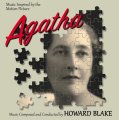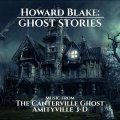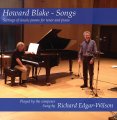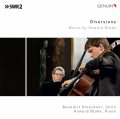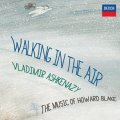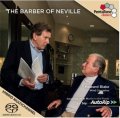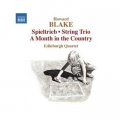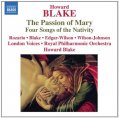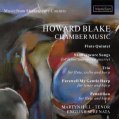 Highbridge Music Ltd.
Highbridge Music Ltd.
Studio 6, 18 Kensington Court Place, London W8 5BJ, UK
Email: howard@howardblake.com
*PIANO TRIO NO. 3 ELEGIA STRAVAGANTE op.654 (January 2014)
Concert work in an extended one-movement form of 7 linked sections
Published by: Highbridge MusicCommissioned by: Benedict Kloeckner
Instrumentation: Violin, cello and piano
[Key to Abbreviations]
Duration: 16 mins
First Performance: September 27th 2014, Koblenz International Music Festival, Linus Roth violin, Benedict Kloeckner cello, Howard Blake piano
Sheet Music Available
Full score for saleStudy score for sale
Piano / Vocal score for sale
Instrumental parts for sale
Full score for hire
Study score for hire
Piano / Vocal score for hire
Instrumental parts for hire
Movements
-
1:
Andante (rapsodico) (October 2013)
Composer's notes: On the afternoon of my birthday I went to sleep for a short while and dreamed up a septuplet 'trill-flourish' motif in C major and an ensuing 'upward-sweeping' melodic fragment of a minor 2nd and major 7th, both of which I immediately wrote down. This was to be the material on which the trio was based.
-
2:
Scherzo malizioso
I was searching for a 6/8 allegro idea and worked at several until I suddenly remembered the 'jazz fugue' from 'Movement for orchestra' which I'd written way back in about 1963. It seemed to fit perfectly and work most effectively for piano trio, forming a perfect link between the Andante (rapsodico) and the next section Tragico.
-
3:
Tragico
Tragico begins with the upward-sweeping motif, but now very slow and sad. This forms a bridge and modulation to E-minor where the cello enunciates the theme 'Parting', a fragment I had dreamt up whilst preparing the repertoire for Vladimir Ashkenazy's album of my piano works in June 2013. Here the 'Parting' theme develops greatly, leading quite rapidly and unexpectedly to a colossal climax, then falling down to a paused low chord of C major which begins section 4.
-
4:
Grave, molto espressivo
Grave molto espressivo is a deeply-felt cadenza for violin and cello which then starts to accelerate (piu mosso) towards section 5
-
5:
Allegro furioso
Cello and violin play in unison at the 16th against a constantly turning piano phrase using the ever-present 'trill-flourish' motif. Martial and tragic hints and twists are now overcome by massive upward scalic movements seeking a major key and suddenly triumphantly asserting that of E major.
-
6:
Giojoso, estatico
Giojoso, ecstatico transforms and inverts the minor 'upward-sweeping' theme into a major 'hymn of triumph' punctuated with huge piano chords. The energy of this is so great however that it must inevitably sink down to regain stability and a hardly-moving harmonic 'thirds duplet' grows gradually quieter and slower until it sinks away to nothing without resolution.
-
7:
Andante, come prima (January 2014)
The music of the opening returns but this time in the key to which the piece has ascended - E major, the final bar picking up the 'trill-flourish' motif and giving the whole work a resolution with a very short coda on violin and cello sounding alone - yet perhaps finally together. The piano is wise enough not to interfere.
-
Notes
Composer’s note:
- 1: Andante (rapsodico) (October 2013)
On the afternoon of the 28th I went to sleep for a short while and dreamed up a septuplet 'trill-flourish' motif in C major and an ensuing 'upward-sweeping' melodic fragment of a minor 2nd and major 7th, both of which I immediately wrote down. This was to be the material on which the trio was based.
- 2: Scherzo malizioso
I was searching for a 6/8 allegro idea and worked at several until I suddenly remembered the 'jazz fugue' from 'Movement for orchestra' which I'd written way back in about 1963. It seemed to fit perfectly and work most effectively for piano trio, forming a perfect link between the Andante (rapsodico) and the next section Tragico.
- 3: Tragico
Tragico begins with the upward-sweeping motif, but now very slow and sad. This forms a bridge and modulation to E-minor where the cello enunciates the theme 'Parting', a fragment I had dreamt up whilst preparing the repertoire for Vladimir Ashkenazy's album of my piano works in June 2013. Here the 'Parting' theme develops greatly, leading quite rapidly and unexpectedly to a colossal climax, then falling down to a paused low chord of C major which begins section 4.
- 4: Grave, molto espressivo
Grave molto espressivo is a deeply-felt cadenza for violin and cello which then starts to accelerate (piu mosso) towards section 5
- 5: Allegro furioso
Cello and violin play in unison at the 16th against a constantly turning piano phrase using the ever-present 'trill-flourish' motif. Martial and tragic hints and twists are now overcome by massive upward scalic movements seeking a major key and suddenly triumphantly asserting that of E major.
- 6: Giojoso, estatico
Giojoso, ecstatico transforms and inverts the minor 'upward-sweeping' theme into a major 'hymn of triumph' punctuated with huge piano chords. The energy of this is so great however that it must inevitably sink down to regain stability and a hardly-moving harmonic 'thirds duplet' grows gradually quieter and slower until it sinks away to nothing without resolution.
- 7: Andante, come prima (January 2014)
The music of the opening returns but this time in the key to which the piece has ascended - E major, the final bar picking up the 'trill-flourish' motif and giving the whole work a resolution with a very short coda on violin and cello sounding alone - yet perhaps finally together. The piano is wise enough not to interfere.
Performances
| 22nd March 2020 | International young artists will compete for a prize to be awarded by recently-appointed Vice-President of the society Howard Blake OBE FRAM along with Vice-President Christine Talbot Cooper. Senior Intercollegiate Piano Trio Competition. Sadly cancelled due to C-virus., Chetham's School of Music, Manchester 10.00am-6.00pm, 22nd. March 2020
The full title of the competition is the Senior Intercollegiate Piano Trio Competition. www.pianotriosociety.org.uk
|
| 9th September 2018 | Solo pianist for performance of 'Speech after long silence' Florian Koltun ; Players for duo
, piano trio and piano quartet - Wolfgang Schroeder (violin), Karolina Herrera(viola), Benedict Kloeckner (cello), Xin Wang(piano), Der Alten Kirche, Spay (nr. Coblenz) 17.00 pm
5th International Music Festival, Coblenz, September 9th 2018
COBLENZ INTERNATIONAL MUSIC FESTIVAL PRESENT A PROGRAMME OF MUSIC BY HOWARD BLAKE TO CELEBRATE HIS 80th YEAR. Der Alten Kirche, Spay, Coblenz, September 9th., 2018 at 17.00 pm 1. SPEECH AFTER LONG SILENCE for solo piano, a piece commissioned by Vladimir Ashkenazy for the Hong Kong International Piano Competition 2011 (Opus 610) solo piano: Florian Koltun 'Unlike most new works, whose fate is to be played on multiple occasions ad nauseam at a competition and then shelved for eternity thereafter, this one promises to be heard rather often. Blake’s partiality for tonality and emotional connection (unsurprising for the composer of the children’s favourite The Snowman) makes this a most accessible work. At about 8 minutes, its Romantic gestures replete with lush harmonies and crashing chords resemble an updated and extended version of one of Rachmaninov’s Etudes-tableaux' Chang Tou Lang, 2. ‘DIVERSIONS FOR CELLO AND PIANO’, the work that in 2010 won Benedict Kloeckner the European Broadcasting Union first prize (Opus 337A) Piano Howard Blake, Cello Benedict Kloeckner 1: Prelude (moderato) 2: Scherzo (vivace) 3: March (tempo di marcia) 4: Waltz (vivo) 5: Aria (andante espressivo) 6: Serenade (allegretto) 7: Sarabande (lento non troppo) 8: Finale (vivo) minutes 27 seconds ‘Diversions’ was originally conceived as a suite for cello and piano as far back as 1973. In 1984 the great French cellist Maurice Gendron encouraged the composer to rework the piece for cello and orchestra, and he himself edited the cello part. The first performance of the work in this orchestral form was given by Steven Isserlis and The Royal Philharmonic Orchestra conducted by Sir Charles Groves at The Fairfield Halls Croydon on 29th March 1989. This transcription for cello and piano was made by the composer at about the same time The work pays mischievous homage to instrumental suites of the past. The Scherzo is not quite a scherzo, the March more than a march. The Waltz has a wrong-stepping jazz tinge to it, the Aria a sudden profundity. The Serenade bursts into arrogant display, the guitar-like Sarabande becomes an eloquent cadenza. We are led back to the theme of the Prelude via a Finale of such bristling virtuosic energy that its simple melodic line assumes a far more complex character – having been well and truly ‘diverted’.Diversions' is also the name of an album of music by Howard Blake for cello and piano played by Benedict Kloeckner and the composer, released in 2015 by the Leipzig label Genuin. ’Benedict Kloeckner plays the cello music of Howard Blake, with the composer himself accompanying - unfailingly attractive and often tremendous fun for both performers and lsiteners., THE STRAD, 2/2018
3. PIANO TRIO NO. 3 ‘ELEGIA STRAVAGANTE’ (Opus 654) a trio in 7 linked movements, first performed at the Coblenz International Music Festival 2013 Violin Wolfgang Schroeder, Cello Benedict Kloeckner, Piano Howard Blake Movements
Composer's notes: On the afternoon of my birthday I went to sleep for a short while and dreamed up a septuplet 'trill-flourish' motif in C major and an ensuing 'upward-sweeping' melodic fragment of a minor 2nd and major 7th, both of which I immediately wrote down. This was to be the material on which the trio was based.
I was searching for a 6/8 allegro idea and worked at several until I suddenly remembered the 'jazz fugue' from 'Movement for orchestra' which I'd written way back in about 1963. It seemed to fit perfectly and work most effectively for piano trio, forming a perfect link between the Andante (rapsodico) and the next section Tragico.
Tragico begins with the upward-sweeping motif, but now very slow and sad. This forms a bridge and modulation to E-minor where the cello enunciates the theme 'Parting', a fragment I had dreamt up whilst preparing the repertoire for Vladimir Ashkenazy's album of my piano works in June 2013. Here the 'Parting' theme develops greatly, leading quite rapidly and unexpectedly to a colossal climax, then falling down to a paused low chord of C major which begins section 4.
Grave molto espressivo is a deeply-felt cadenza for violin and cello which then starts to accelerate (piu mosso) towards section 5
Cello and violin play in unison at the 16th against a constantly turning piano phrase using the ever-present 'trill-flourish' motif. Martial and tragic hints and twists are now overcome by massive upward scalic movements seeking a major key and suddenly triumphantly asserting that of E major.
Giojoso, ecstatico transforms and inverts the minor 'upward-sweeping' theme into a major 'hymn of triumph' punctuated with huge piano chords. The energy of this is so great however that it must inevitably sink down to regain stability and a hardly-moving harmonic 'thirds duplet' grows gradually quieter and slower until it sinks away to nothing without resolution.
The music of the opening returns but this time in the key to which the piece has ascended - E major, the final bar picking up the 'trill-flourish' motif and giving the whole work a resolution with a very short coda on violin and cello sounding alone - yet perhaps finally together. The piano is wise enough not to interfere
4. PIANO QUARTET (Opus 179) Xin Wang (piano), Wolfgang Schroeder (violin), Karolina Herrera (viola), Benedict Kloeckner (cello)
A dramatic theme A (and in A minor) is presented by unison violin and viola over a pounding rhythm that would be equally at home in rock. A second theme B is equally rhythmic on contrapuntal strings over hammering piano semiquavers but subsides into a lyrical C minor piano version of A against legato strings. This subsides further again into a Theme C (and in C major) announced by the cello. It is spread across the three strings against piano chords gradually dying down to a held F sharp unison. This kicks off the development by taking us back to the first tempo but this time featuring theme B with running semiquavers which build and build until a pedal pulls us back into a full-bodied return of our home theme A on full strings and rocking piano chords.
A very fast tempo allows all instruments to fly through a Scherzo of heavily-syncopated rhythms and riotous escapades. It follows the scherzo form with a trio featuring predominantly piano against pizzicato cello, but they yield to questioning phrases on violin and viola before recapping to the scherzo and a noisy coda.
3. Lento espressivo
4.Allegro robusto Notes The opening of the first movement is used as a signature theme by KUSC, the audience-supported classical music radio station of the University of Southern California. Its composer is delighted and honoured by this
|
| 15th December 2016 | The Bedriska Trio, The Menuhin School |
| 21st June 2015 | Daniel Bhattacharya, violin, Bruce White, viola, Peter Adams cello, Sasha Grynyuk, piano, Brighton Unitarian Church, New Road, Brighton, BN1 1UF concert Sunday 5.00pm
A concert of music by Howard Blake presented by The Brighton Philharmonic Society including the premiere of Piano Trio no,1 composed in Brighton when the composer was 17,
|
| 17th April 2015 | Madeleine Mitchell (violin), Rivka Golani(viola), Benedict Kloeckner (cello), Sasha Grynyuk (piano), Milton Court, The Barbican, London Concert arranged by Lisa Peacock |
| 14th March 2015 | Noe Inui vn., Vassilis Varveresos pno., Benedict Kloeckner vc., Recital Hall, Gasteig, Munich
First performance in Munich |
| 4th December 2014 | Howard Blake piano, Madeleine Mitchell violin, Rosalind Ventris, viola, Peter Adams cello, Gloucester Music Society |
| 27th September 2014 | Internationales Musikfestival Coblenz
In the first Internationales Musikfestival Coblenz, Germany, the premiere of Blake's new Piano Trio 'Elegia Stravagante' was given an electrifying performance by violinist Linus Roth, Benedict Kloeckner cello and the composer Howard Blake himself at the piano. A capacity audience in the Goerrehaus gave an enthusiastic and repeated ovation, causing an immediate encore. |
Reviews
BRIGHTON PHILHARMONIC SUMMER MUSIC
Solstice, and the first of the Summer Season of chamber concerts which have now become a familiar feature of Brighton Philharmonic’s programme. Howard Blake is a very familiar figure as a result of his many film scores – to say nothing of The Snowman – but his other compositions are equally appealing. Though a recent injury to his wrist meant he was not able to play the piano parts himself he was present to introduce the music with a gentle humour which suited the occasion and the intimacy of the setting.
The short programme reflected a long-standing interest in the complexity of writing for chamber instruments, opening with a recent arrangement of Pennillion for cello and piano. Originally conceived for harp and piano, it has gone through a number of arrangements before arriving at the present one. The opening melody is intensely lyrical. Blake’s melodic gift is similar to that of Elgar or Tippett in that the melodies seem so inevitable that we can’t believe we have not known them all our lives and he is just recalling a tune we all know already. The work moves rapidly through a set of variations which allow the cellist, Peter Adams, to show his technical skill as well as his sensitivity towards the subtleties of the melody.
The following Fantasy Trio was being given its first performance though the original idea for the score goes back to his early school days. It is obviously difficult on a first hearing to judge how much is the work of the 17 year old and how much the mature composer, but the melodic ideas and the confidence of the work must have been part of the original spark and as such are a tribute to his genius from an early age. The part writing is exemplary, maintaining a balance between them which never allows one voice to dominate. The final Scherzando is more complex both in rhythm and harmonic density.
Howard Blake admitted that the String Trio is probably the most challenging form for him as it constantly misses the fourth note of the chord. The Trio dating from 1975 is a fierce work with a dark edge to it, strengthened by the deeper tones of viola and cello. The violin, Daniel Bhattacharya, takes the lead throughout though he is often challenged by the viola line from Bruce White.
The final piece was a recent extended single movement entitled Elegia Stravagante – a title suggested by a waiter as it is a reflective elegy which ends with unexpected enthusiasm. Though Howard Blake admitted there are strong auto-biographical elements within it, the piece moves rapidly as a whole with universal rather than personal impact. The seven sections are difficult to follow but the sense of achievement by the climax is persuasive.
As Howard Blake was not able to play the piano parts Sasha Grynyuk proved to be a more than ample substitute, bringing a fine mix of subtlety and bravura to his playing.
The next concert is on Sunday 5 July with music by Frank Bridge and Haydn.
Lark, 21/6/2015
Brighton Philharmonic Summer Season – Howard Blake
The new season began brilliantly! Peter Adams, the Philharmonic’s popular principal cello, was the virtuoso backbone of four chamber works covering the entire span of Brighton-bred Blake’s distinguished career. From the re-worked teenage Fantasy-trio of 1956 to last year’s ‘Elegia Stravagante’, each work was full of glorious melody and rhythmic complexity. The composer’s amiable introductions and helpful programme notes illuminated these delightful works even more. Blake is still recovering from a broken wrist so the piano part was played, at just a few days’ notice, by the excellent Sacha Grynyuk. Daniel Bhattacharya (violin) and Bruce White (viola) completed the ensemble.
Unitarian Church Brighton 21 June 2015
Andrew Connal, Classical Reviews, 21/6/2015

